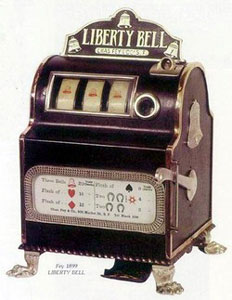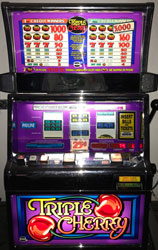History of Slots
If you play slot games on a regular basis, you probably don’t really stop to acknowledge how different gaming is today from when it first started. In fact, if you don’t play slots regularly, you’re even less likely to realize that. But it’s really a fascinating journey that slot games have been on since their creation. They have evolved greatly over time. And over the past couple of decades, the internet has thrust gaming onto a completely new level. So, why not just take some time to appreciate how we went from classic, old-school one-arm bandits to today’s ultra-modern, flashy 3D bundles of entertainment. Buckle up, because we are taking you on a journey across time.
 The Ghost of Slot Games Past
The Ghost of Slot Games Past

 Where did it all begin? How did the flamboyant, loud, and hectic online slot games of today initially start out? What were the first slot machines, and what was it like to play them? And why are slot machines called that, anyway?
Where did it all begin? How did the flamboyant, loud, and hectic online slot games of today initially start out? What were the first slot machines, and what was it like to play them? And why are slot machines called that, anyway?
Believe it or not, but the concept of slot machines as we know them is actually over a century old. And it all began in distant 1894 in San Francisco, California, with a man named Charles August Fey. At the time, Mr. Fey was working as a mechanic when he built his first gambling machine. He had spent some time studying the mechanical nickel-in-the-slot machines of the time, which was the inspiration for his own model. (That is, by the way, where the shortened term “slot machine” that we now use comes from.)
The 4-11-44 had a long cabinet with 3 concentric dials on it. This subsequently led to Fey opening his own slot machine factory and producing the Liberty Bell slot. It was made of cast iron and had three separate reels that operated independently from one another. Each held a total of 10 symbols. And those symbols were a star, horseshoes, playing cards, and bells. In order for you to win, you had to line up three symbols of a kind on the one payline. Does this sound familiar?
This is exactly what many classic-themed online slot games represent even today. Liberty Bell was the first and most famous slot machine to come out of Fey’s factory. But the factory also released a number of other slot machines, such as Klondike.
Talk about determination to circumvent the law, huh? Speaking of cash, do you know why slot machines were really called the one-arm bandits? It’s because they held onto up to 50% of the money. Can you imagine playing a game today with only a 50% return? Nobody would ever play it!
 The Electromechanical Era
The Electromechanical Era

After a series of innovations that followed from Fey’s merge with Mills Novelty Company, electricity was introduced to slot machines. And with that, one of the most famous electromechanical slot games was born – the Big Bertha. It has a very specific look, and its mechanism of play certainly also stands out in comparison to other slot machines of the time. Big Bertha was far more complex than its contemporaries and also a lot more expensive to produce. As a matter of fact, the production of just a single Big Bertha was a whopping $150,000.
The popularity of slot machines kept on increasing through the 1920s and into the ‘30s. However, with mobsters and organized crime being their main locomotive, slots were still against the law in all of the US. Nevada was the first and only – at the time – state to relegalize gambling in 1931. However, this still didn’t stop private clubs and resorts in other states from housing slot machines.
It wasn’t until World War II, though, that the rest of the world also decided to join the party. Right up until that point, slot machines were virtually unknown anywhere outside of the United States. And do you know what triggered this sudden global expansion?
Tax revenue. That’s right, folks – as usual, just follow the money. The governments of a devastated-by-war Europe were eager to have a new means getting of income.
 Video Slot Machines
Video Slot Machines

 It was the year 1975, the hippie culture was in its prime, and Las Vegas was already the desert gambling haven that it still is today. On top of that, it is where the first video slot machine first became a reality. It was manufactured by the local company Fortune Coin and actually used a 19-inch Sony TV as its display. The screen showed a simulation of the actual reels and first became available in the Las Vegas Hilton Hotel.Then, following some tweaking and altering, the Nevada State Gaming Commission approved of this new type of slot machine. And soon, video slots were everywhere in Las Vegas. However, their success was far from what you’d expect. People still craved the thrill of pulling the handle and the excitement of hearing the reels spin. So, the first video slots didn’t quite do so well to begin with.
It was the year 1975, the hippie culture was in its prime, and Las Vegas was already the desert gambling haven that it still is today. On top of that, it is where the first video slot machine first became a reality. It was manufactured by the local company Fortune Coin and actually used a 19-inch Sony TV as its display. The screen showed a simulation of the actual reels and first became available in the Las Vegas Hilton Hotel.Then, following some tweaking and altering, the Nevada State Gaming Commission approved of this new type of slot machine. And soon, video slots were everywhere in Las Vegas. However, their success was far from what you’d expect. People still craved the thrill of pulling the handle and the excitement of hearing the reels spin. So, the first video slots didn’t quite do so well to begin with.
The next important mark in the slot machine timeline would be the introduction of a second-screen bonus round. That is when you trigger the bonus feature of a game, and a new screen appears where the bonus plays out. Developer WMS, another well-known company today, was responsible for this revolutionary act. Interesting, isn’t it, how something we see every day and pretty much take for granted actually had to happen for the first time? And the year was 1996 when it did.
And at this point, slots literally just blew up. They took up over two thirds of the floor space in casinos and were responsible for earning some 70% of the overall revenue.
 Modern Days
Modern Days

It’s no secret that the internet acted as the ultimate catalyst in creating today’s image of gambling. The very first online casinos became available in the mid-1990s, and with them, the first online slot games. Even though it was games like roulette and blackjack that were on offer at first, slots quickly established their dominance in the online casinos – same as they did in live casinos.
In the beginning, however, online slots hardly differed from their land-based counterparts. They mirrored their symbols, setups, layouts – everything. But it wasn’t long before software manufacturers embraced the freedom that computer developing gave them.
Now, all of a sudden, it isn’t simply about spinning the reels and hoping to land a winning combination. Developers started layering the whole experience, adding more and more depth to it. Today, a slot game has so many aspects to it, besides just the technical specs. You have the theme to consider and how well the gameplay merges with that theme. Are there special features? Do those interlace nicely with the theme, too? Is there music? How about sound effects? Can you control these, and what else will the controls allow you to regulate?
Furthermore, are the graphics agreeable? The competition nowadays is immense, and unless the visuals are flawless, players might not be that tempted by an offering. In fact, we have become so spoiled today that if the graphics are anything less than 3D and if the character doesn’t wink at us from the screen, we will likely go spend our money elsewhere.
Oh, and let’s not forget the mobile-friendly games. You have to be able to take them with you everywhere you go, right? Otherwise, what’s the point? This insane popularity that online slot games now enjoyed thanks to the ease of access, for one, also sparked the establishment of many new developers. We have titans like NetEnt, Microgaming, Betsoft, and a few others. But there are also many younger and very innovative names out there that are pretty serious competitors.
Then we have relatively new companies like Thunderkick or Elk Studios, for example, that produce games that totally bend your perception of slot machines. They go above and beyond what “the rules” are and release these little masterpieces, both in terms of the visuals, as well as the setup. And as time goes by, software manufacturers just have to keep on getting more creative to stay on top. Those of us consumers or mere spectators can only sit in awe and wonder at what else can possibly be done.
How far can software providers push boundaries, and what have we not yet seen? And just as you think this niche has reached its peak of innovation… someone just surprises you with something no one has ever done before. Or even thought of. So, who knows how many more innovations we will witness in our lifetime? Perhaps we’re on the brink of a new breakthrough as we speak?

 MENU
MENU










